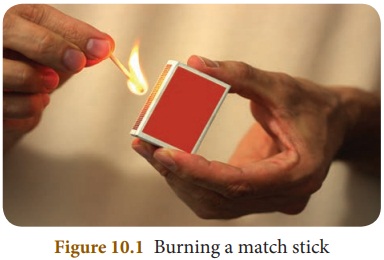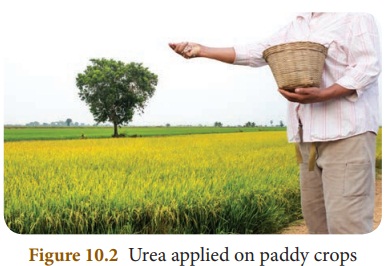Changes Around Us | Chapter 10 | 8th Science - Factors determining Chemical changes | 8th Science : Chapter 10 : Changes Around Us
Chapter: 8th Science : Chapter 10 : Changes Around Us
Factors determining Chemical changes
Chemical changes
A chemical change is a permanent and
irreversible change which produces a new substance. Chemical changes are
otherwise called as chemical reactions, because one or more substances
(reactants) undergo a reaction to form one or more new substances (products).
Reactant(s) → Product(s)
Factors determining
Chemical changes
Chemical changes will not occur at
all conditions. For a chemical change to take place, certain specific
conditions are required. Chemical changes can take place in the following
conditions.
a. Contact in physical states
b. Solution of reactants
c. Electricity
d. Heat
e. Light
f. Catalyst
a. Contact in physical states
We experience many events in our
daily life like burning of matchstick on rubbing and iron materials turning
into reddish brown. Why and how these changes happen?
These changes are due to chemical
reactions by contact in physical states. Combination of reactants in their
naturally occurring states (solids, liquids, gases) is referred as contact in
physical states.
* When dry wood comes into contact
with fire, it burns with the help of oxygen to form carbon dioxide, which is
given out as smoke.
* When a matchstick is rubbed on the
sides of a matchbox, a chemical reaction takes place to form heat, light and
smoke.
* When quick lime (calcium oxide)
comes into contact with water, it forms slaked lime (calcium hydroxide).

More to know
The head of a
matchstick contains potassium chlorate and antimony trisulphide. The sides of
the matchbox contain red phosphorous.
From the above reactions, we can
conclude that certain chemical reactions take place only when the reactants are
brought in contact with each other in their physical states.
Activity 2
Take two test tubes
and couple of rust free iron nails. In one test tube pour some water and put an
iron nail. Keep the test tube opened for few days. Take another test tube and
pour some water along with some coconut oil. Now, place the second iron nail.
Leave the set up for a few days. Observe the changes and record them. Which
iron nail gets rusted and why?
b. Solution of reactants
When milk is mixed with coffee
decoction the colour of the milk and the decoction changes due to chemical
reaction. Similarly, when we mix two substances (reactants) in solution form, a
chemical reaction takes place between them to form new substances (products).
For example, take small amount of solid silver nitrate and sodium chloride in a
test tube. Do you observe any change? No, because the reactants in solid state
have no recation. Now, you dissolve the same reactants in water in a separate
test tubes and mix both the solutions. What do you observe? Silver nitrate
solution reacts with sodium chloride solution to form a white precipitate of
silver chloride and sodium nitrate solution. From the above reaction, we infer
that some chemical reactions proceed only in solution form not in solid form.
c. Electricity
Electricity is essential for our
living. We use electricity for cooking, lighting, grinding, watching television
etc. Do you know electricity can be used to carry out chemical reactions also?
Many chemical reactions which take place with the help of electricity are
industrially very important. As you know, water is made of hydrogen and oxygen
molecules. When electricity is passed through water which contains small
amounts of sulphuric acid, hydrogen and oxygen gases are liberated. Similarly,
a concentrated solution of sodium chloride called brine is electrolysed to
produce chlorine and hydrogen gases along with sodium hydroxide. This is an
important reaction to produce chlorine industrially.
Thus, we can conclude that some
chemical reactions proceed only by the passage of electricity. Hence, such
reactions are called as electrochemical
reactions or electrolysis.
The term electrolysis was
introduced by Michael Faraday 19th in the century. The word electrolysis is
acombinationoftwo terms‘electron’ and ‘lysis’. Electron is relatedto
electricity and lysis means decomposition

d. Heat
Food is important for our survival
and also for the survival of many other living beings. Have you ever closely
watched your mother cooking food? She boils rice, cooks vegetables, and
prepares gravy by heating them over stove. When enough heat is given some
chemical reactions take place to convert the raw food (uncooked) items into
cooked ones.
You can learn more about this by
conducting a reaction in your laboratory.
More to Know
Chemical reactions
accompanying evolution of heat are called exothermic reactions. Whereas
chemical reactions which involve absorbtion of heat are called endothermic
reactions.
Take a small amount of lead nitrate
in a dry test tube and heat it gently over a flame. Observe the changes
closely. You will hear cracking sound and an evolution of reddish brown
coloured gas (nitrogen dioxide). In industries limestone rocks are heated to
get quicklime (calcium oxide) . Hence, some chemical reactions can be achieved
by the supply of heat only. These reactions are called thermo chemical reactions
or thermolysis.
Limestone is the raw
material for quicklime, slaked lime and cement.

e. Light
What will happen if there is no
sunlight? All the living organisms will be affected and there will be no food
for us to survive, is n’t it? Sunlight is important not only for us but also
for plants. As you know photosynthesis (‘photo’ means light and ‘synthesis’
means production) is a process in which light energy from the sun is used by
the plants to prepare starch from carbon dioxide and water. The sunlight
induces the chemical reaction between carbondioxide and water, which finally
ends up in the production of starch. Thus, chemical reactions induced by light
are called as photochemical reactions.
The ultraviolet rays
from the sun break ozone (O3) molecules in the stratosphere into
molecular oxygen and atomic oxygen. This atomicoxygen again combines with
molecular oxygen to form Ozone.
More to Know
Photochemistry is the branch of chemistry
which deals with chemical reactions involving light.
f. Catalyst
Sometimes you are advised by the
elders to drink a small amount of ‘oma water’ after a heavy meal. Do you know,
why? This is because oma water makes digestion faster. Likewise, in industries
some chemical substances are used to speed up chemical reactions. These
substances are called catalysts. For example, metallic iron is used as a
catalyst in the manufacture of ammonia using Haber’s process. This ammonia is
the basic material for the production of urea, an important fertilizer in
agriculture. In vanaspati ghee (dalda) preparation, finely divided nickel is
used as a catalyst. Thus, speed of certain reactions is influenced by the
catalysts and such reactions are called catalytic
reactions.

Enzymes and yeasts are
called ![]() biocatalysts.
biocatalysts.

Activity 3
Buy some fresh yeast from a grocery shop. Prepare a paste of wheat flour with water in a vessel. Add some yeast and leave the vessel closed for few hours under sunlight. Observe the changes closely. What do you infer?
Related Topics